
About UsThe Numismatic Bibliomania Society is a non-profit organization promoting numismatic literature. For more information please see our web site at coinbooks.org SubscriptionsThose wishing to become new E-Sylum subscribers (or wishing to Unsubscribe) can go to the following web page link MembershipThere is a membership application available on the web site Membership Application To join, print the application and return it with your check to the address printed on the application. Membership is only $15 to addresses in the U.S., $20 for First Class mail, and $25 elsewhere. For those without web access, write to: David M. Sundman, Secretary/TreasurerNumismatic Bibliomania
Society AsylumFor Asylum mailing address changes and other membership questions, contact David at this email address: dsundman@LittletonCoin.com SubmissionsTo submit items for publication in The E-Sylum, just Reply to this message, or write to the Editor at this address: whomren@coinlibrary.com
BUY THE BOOK BEFORE THE COINYou won't regret it! |
- WAYNE'S WORDS: THE E-SYLUM SEPTEMBER 27, 2009
- SELECTED SKLOW OCTOBER 3, 2009 LITERATURE SALE LOTS
- LAKE BOOKS 100TH SALE CATALOG AVAILABLE
- NEW BOOK: THE FEEL OF STEEL - BANK NOTE ENGRAVING IN THE U.S.
- STELLA COIN NEWS POSTS LAWRENCE BARBER HALVES GUIDE ONLINE
- ROLLIE W. FINNER, 1934-2009
- NOMISMA.ORG: "COMMON CURRENCY FOR DIGITAL NUMISMATICS"
- COMMENTS ON THE RED BOOK OF U.S. COINS - PROFESSIONAL EDITION
- CORRECTION: IMAGES OF GRATIANUS SOLIDUS FROM THE LYONS MINT
- UPDATE: THE NUMISMATIC INDEX OF PERIODICALS
- INDEX OF ARTICLES OF INTEREST IN NON-NUMISMATIC PUBLICATIONS
- PUBLISHING BOOKS, ONE COPY AT A TIME
- WILLIAM H. WOODIN
- NOTES ON JOHN KITTREDGE
- MORE ON THE STANDING LIBERTY QUARTER DATE
- MORE ON THE 1959 HAWAII GOLD STATEHOOD MEDAL
- COINS PICTURED ON BANKNOTES
- MORE ON ADMIRAL NELSON'S MEDALS
- MORE ON THE YOACHUM DOLLAR MYSTERY
- QUERY: THE ORIGIN OF COIN AND MEDAL DIE ALIGNMENT
- QUERY: CATALOG DESCRIPTIONS OF RARITY
- THE U.S. MINT AT THE DULLES, OREGON
- NEWSPAPER ARTICLES HIGHLIGHT MARK YAFFE'S ORCHESTRIONS
- FORMER ANA EXECUTIVE DIRECTOR FACES HEARING MONDAY
- RARE CENTS OF WILLIAM THE CONQUEROR UNCOVERED
- AN UNPARALLELED FIND OF ANGLO-SAXON GOLD AND SILVER
- MALAYSIA'S MAYBANK NUMISMATIC MUSEUM
- FEATURED WEB SITE: KYOTO UNIVERSITY'S ECONOMIC REVIEW
WAYNE'S WORDS: THE E-SYLUM SEPTEMBER 27, 2009

Among our recent subscribers are John Fryar, courtesy of Bob Laetare, and Michael Wierzba. Welcome aboard! We now have 1,268 subscribers.
I had several new reports of missing issues again this week. I contacted Binhost support, and they tell me they found a queue of held-up messages and released them Saturday evening. Those of you who had been missing previous issues may have them by now. If you've written to me before about this problem, please let me know if you've received your issues.
This week we open with word from literature dealers Sklow and Lake, and an announcement of an amazing new book on bank note engraving. Also in this issue, readers comment on the new Professional Edition of the Red Book, we learn the status of the NIP index, and Dick Johnson proposes a new index to numismatic content in non-numismatic publications.
Other topics include publishing on demand, William Woodin, John Kittredge, Rollie Finer and Admiral Nelson (and his many medals). Other follow-ups from earlier articles include the 1959 Hawaii gold statehood medal, and the Yoachum dollar.
For humor this week, Dick Johnson writes: "If Senator Jim DeMint had a medal made it should be struck at the Denver Mint. DeMint by D Mint!"
To learn about Nelson's Gold Nile medal and Mark Yaffe's orchestrions, ponder the true origin of medal and coin die alignments, and debate catalog descriptions of rarity, read on.
Wayne Homren
Numismatic Bibliomania Society
SELECTED SKLOW OCTOBER 3, 2009 LITERATURE SALE LOTS
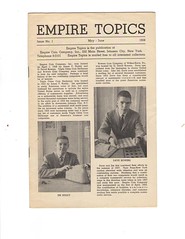 803. Empire Coin Company {Bowers, Q. David and Ruddy, James}. EMPIRE TOPICS. Johnson City, N.Y. 1958-1960. Issue No. 1-11 complete as issued. 8vo. Original paper covers as issued. The very elusive first periodical or house organ of Q. David Bowers in conjunction with his partner Jim Ruddy; produced in eleven issues under this title; rarely does this appear in complete form; Davis 376: Very Good/Fine. (150.00)
803. Empire Coin Company {Bowers, Q. David and Ruddy, James}. EMPIRE TOPICS. Johnson City, N.Y. 1958-1960. Issue No. 1-11 complete as issued. 8vo. Original paper covers as issued. The very elusive first periodical or house organ of Q. David Bowers in conjunction with his partner Jim Ruddy; produced in eleven issues under this title; rarely does this appear in complete form; Davis 376: Very Good/Fine. (150.00)
818. Spadone, Frank. THE FLYING EAGLET. Newark, N.J. 1956-1959. Twenty-nine issues. 4to.Various paper covers. [Vol. 1 # 11 & 12], [Vol. 2 # 1], [Vol. 3 # 3-12], [Vol. 4 # 1-12 complete], [Vol. 5 # 1-6];
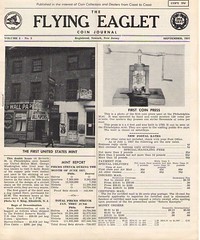 A privately produced monthly coin magazine in the interest of coin collectors and dealers from coast to coast; by volume 4 in 1958 it was boasting to be "The Largest Circulating Publication In The East"; it was well written, featuring many articles and an abundance of advertising; in 1959 its name would become "The Coin News Magazine";
A privately produced monthly coin magazine in the interest of coin collectors and dealers from coast to coast; by volume 4 in 1958 it was boasting to be "The Largest Circulating Publication In The East"; it was well written, featuring many articles and an abundance of advertising; in 1959 its name would become "The Coin News Magazine";
Of great interest is Volume 3 issue # 5 September 1957 where the front page features a photograph of the First Mint in Philadelphia that this cataloger has never seen before; almost all the issues have the name imprinted on the cover of the person the issues was mailed to; a wealth of information; some folds, creases and a few tears; Good/Fine. (75.00)
LAKE BOOKS 100TH SALE CATALOG AVAILABLE
Lake Books is pleased to announce that our one-hundredth mail-bid sale of numismatic literature is now available for viewing on our web site at www.lakebooks.com/current.html
The 406-lot catalog contains reference material for the full gamut of the numismatic experience. Early works include a plated volume from 1557 and the most up-to-date emissions are listed in abundance.
The 406-lot sale has a closing date of Tuesday, October 27, 2009 at 5:00 PM (EDT) and bids may be sent via regular mail, telephone, email or fax.
Your continued interest in our sales for these twenty years is very much appreciated.
NEW BOOK: THE FEEL OF STEEL - BANK NOTE ENGRAVING IN THE U.S.
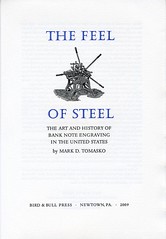 First edition, limited to only 150 numbered copies. Those interested in printing and finely-printed books are familiar with and knowledgeable regarding the history and practice of letterpress printing. But we are much less familiar with the process of intaglio, which produces printed images from engraved metal plates.
First edition, limited to only 150 numbered copies. Those interested in printing and finely-printed books are familiar with and knowledgeable regarding the history and practice of letterpress printing. But we are much less familiar with the process of intaglio, which produces printed images from engraved metal plates.
The "feel of steel" is that tactile experience one gets from a well-printed intaglio plate. The collector of antiquarian books knows the engraved portraits and illustrations which commonly appear in many 19th and early 20th century books. Such work was often done by artists who may also have been skilled designers and engravers of bank notes and even the coins of the U.S. Mint.
 The creation of high quality intaglio work is a far more demanding discipline than letterpress printing. As described in this book, the training of engravers required a long period of work and study. Intaglio was a much slower and more costly process but it produced magnificent images that could be achieved in no other way.
The creation of high quality intaglio work is a far more demanding discipline than letterpress printing. As described in this book, the training of engravers required a long period of work and study. Intaglio was a much slower and more costly process but it produced magnificent images that could be achieved in no other way.
This book is a companion to the previous The Private Typecasters, in that it also deals with an almost-vanished graphic procedure. The intaglio process remains an essential and attractive part of the history of the printed image. The pictures on bank notes and securities, termed "vignettes", were the work of the highest class of engravers in the profession, and have long been prized by collectors.
A nine-page insert of original engraved prints includes fourteen such vignettes. These have been printed from old engraved plates especially for this book by Michael Bean, a retired Bureau of Engraving and Printing plate printer, who also printed the frontispiece, Atlantic and Pacific United 1865. This portrays an allegorical female representing the transcontinental railroad. This handsome engraving is one of the largest vignettes used in security documents in the nineteenth century.
There are 32 pages of color illustrations and four engraved samples tipped or bound in. Caught up in the wave of intaglio, the book printer tried his hand at "printing intaglio by letterpress" and his two prints form a very modest addition to the work.
We are delighted to be able to sell this informative and engaging work by an author as knowledgeable as Mark Tomasko. For years Mark has been engaged in collecting, writing, and research, documenting the people (engravers, designers, vignette artists, and others), the process, and the bank note companies. Mark has written numerous articles on the subject of bank note engraving, given talks, and done a number of museum exhibits, ending up as one of the primary historians of this art.
The Feel of Steel is a 177-page small folio printed by letterpress on Zerkall moldmade paper and quarter bound in morocco with Japanese cloth sides.
Mark Tomasko adds:
Bird & Bull Press is one of the country's leading private press printers. The book is printed from metal type on Zerkall mold-made paper. B&B books are quite collected by fine printing people, including leading research institutions. It is an edition of 150 copies, and contains, beyond a number of colored illustrations, a few "samples" (bank note, stock certificate, and wine label). Bound in the back is a portfolio of vignettes and portraits printed for the book, with descriptions.
In terms of the text I do not spend much time on the pre-Civil War era. I concentrate on American Banknote's existence and particularly the small companies that started to appear in the 1870s-1890s and subsequently. There is some unusual information, such as ABN's 1859 Russian sale, their Italian Bank Note Co. effort, etc. There is quite a bit on the process.
The books are sold by B&B Press, not me, and I receive no financial benefit from the sale of the books. A decent portion of the edition was sold by B&B to standing subscribers at the outset.
For more information, see: http://oakknoll.com/detail.php?d_booknr=103136 or contact George Kolbe at GKF@numislit.com
STELLA COIN NEWS POSTS LAWRENCE BARBER HALVES GUIDE ONLINE
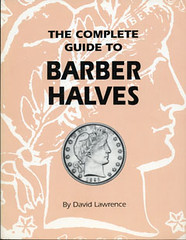 Stella Coin News is excited to announce that the long awaited reference book, The Complete Guide to Barber Halves has been added to their FREE online library. Originally published in 1991 by late author, David Lawrence, the ground-breaking reference is now available to all collectors free of charge for their personal use.
Stella Coin News is excited to announce that the long awaited reference book, The Complete Guide to Barber Halves has been added to their FREE online library. Originally published in 1991 by late author, David Lawrence, the ground-breaking reference is now available to all collectors free of charge for their personal use.
This rare book has been out of print for some time and The Complete Guide to Barber Halves will be useful to entire numismatic community. You will find an in-depth analysis and die variety study on this series, as well as relative rarity rankings. We encourage added comments and updated information on this series.
Coming soon to Stella Coin News
- The Complete Guide to Certified Barber Coinage
- The Complete Guide to Shield & Liberty Head Nickels
- The Complete Guide to Liberty Seated Half Dimes
The following reference books are now available on the SCN web site to all users:
- Tales from the Bourse by David Lawrence Feigenbaum
- Hobo Nickel Book by Joyce Ann Romines
- The Complete Guide to Buffalo Nickels, 3rd edition by David Lange
- The Complete Guide to Mercury Dimes, by David Lange
- The Complete Guide to Washington Quarters, by John Feigenbaum
- The Complete Guide to Liberty Seated Half Dollars, by Randy Wiley and Bill Bugert
- The Complete Guide to Walking Liberty Half Dollars, by Bruce Fox
- The Complete Guide to Franklin Half Dollars, by Rick Tomaska
- The Complete Guide to Barber Dimes, by David Lawrence
- The Complete Guide to Barber Quarters, by David Lawrence
- The Complete Guide to Barber Halves, by David Lawrence
To read the complete article, see: Renowned Reference "The Complete Guide to Barber Halves" Added to Stella Coin News (www.stellacoinnews.com/index.php/renowned-reference-the-complete-guide-to-barber-halves-added-to-stella-coin-news/)
THE BOOK BAZARRE
ROLLIE W. FINNER, 1934-2009
"Rollie Finner, longtime Editor of the Centinel, former Governor and the voice of Central States at several convention message centers, passed away on September 18 at the Iola Living Assistance, Iola, Wisconsin. Rollie is survived by our President, Patti (Jagger) Finner. The family requests that memorials be given to the Iola Living Assistance, 186 Chet Krause Drive, Iola, WI 54945. Rollie was the complete collector and numismatist whose knowledge of our great hobby was well-known. Rollie was a "go-to-guy" when answers were needed for numismatic questions. His sense of humor, enthusiasm and sincerity will be greatly missed. "
For more information, see:
Rollie W. Finner
(http://www.meaningfulfunerals.net/fh/obituaries/
obituary.cfm?o_id=427685&fh_id=12037&s_id=ADAFFF90F284D832778A680FEB87DEBA)
NOMISMA.ORG: "COMMON CURRENCY FOR DIGITAL NUMISMATICS"
The American Numismatic Society Enews for September 2009 announced:
The ANS has received a $10,000 grant from the Dispersed Authority Ecologies project based at Stanford University. One goal of this project, which is under the direction of Ian Morris, Josiah Ober, and Barry Weingast, is to create multiple, interacting databases focusing on different data sets from the ancient world. Greek curator Dr. Peter van Alfen has been involved in this project from its inception two years ago. The grant will be used on a joint ANS-Stanford University-French initiative to digitize the Inventory of Greek Coin Hoards.
From the project web site:
Nomisma.org is a collaborative effort to provide stable digital representations of numismatic concepts and entities, for example the generic idea of a coin hoard or an actual hoard as documented in the print publication An Inventory of Greek Coin Hoards (IGCH). Nomisma.org provides a short, often recognizable, URI for each resource it defines and presents the related information in both human and machine readable form. Creators of digital content can use these stable URIs to build a web of linked knowledge that enables faster acquisition and analysis of well-structured numismatic data.
As a test case, Nomisma.org is developing a digital version of IGCH. All 2387 hoards have been assigned stable URIs and the text from the original publication is online. IGCH is a good dataset with which to explore the potential of nomisma.org because its stable entities, hoards as identified by a unique number, are well known within the field of ancient numismatics.
For more information, see: www.nomisma.org
COMMENTS ON THE RED BOOK OF U.S. COINS - PROFESSIONAL EDITION
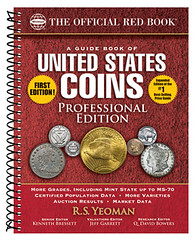 Regarding the new Professional Edition of the Guide Book of United States Coins, Alan Luedeking writes:
Regarding the new Professional Edition of the Guide Book of United States Coins, Alan Luedeking writes:
Very interesting. What is even more interesting, however, is what is in the regular edition that is not in the Professional Edition, thereby requiring a collector to own both?
Gary Dunaier had similar thoughts.
Something in the press release about the new Professional Edition of the Red Book concerned me. According to Whitman Publisher Dennis Tucker,
"The Professional Edition is a companion to the regular-edition Red Book, not a replacement. Each book contains information that the other doesn't, and each will be published annually."
Does that mean we're going to have to buy TWO different Red Books in order to have all the information contained in the Red Book? I was under the impression that the Professional Edition would basically be a more specialized edition of the Red Book, but I don't see how publishing an advanced Red Book that doesn't include ALL of the information contained in the traditional version is going to be helpful to anyone.
Joe Boling was the third to chime in. He writes:
So what's in the Professional Edition of the Red Book that is not in the standard edition? If I were a dealer, I'd want to know A) what do I have to look in the smaller book to find, and B) why the dickens that information is not in the Professional Edition? Publishers who intentionally and unnecessarily create a requirement to buy two books when one ought to be adequate do NOT endear themselves to me.
Here's another example - Krause Publications seems to be marketing only 2/3 of the paper money volumes in their combined CD set - the Specialized Issues volume is missing. They weasel-worded it as "all types of paper money, issued by every country, since 1368." Technically that's almost correct, because the notes in the Specialized Issues edition are LARGELY (not completely) bank and regional issues, not national issues, but it's still a tremendous hole in the catalog if one is a paper collector - over 1,150 pages' worth.
CORRECTION: IMAGES OF GRATIANUS SOLIDUS FROM THE LYONS MINT
Regarding Philippe de Henaut's query about the Gratianus Solidus from the Lyons mint, Michael Luck writes:
Look at the three figures provided, Figure One and Figure Three are the same coin. How can this be? A mix up?
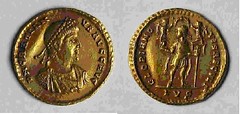
Fig. 1 - Specimen from the Cabinet des Médailles
de la Bibliothèque nationale de France, © BnF
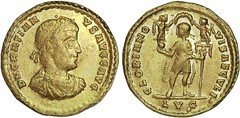
Figure 2 - Specimen from a private collection, © CGB
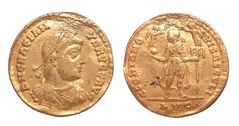
Figure 3 - Specimen from Münzkabinett,
Staatliche Kunstsammlungen Dresden, © Dresen
I got worried as I thought maybe the Lyons gold coin was first in one European collection then passed somehow through fate to another.
To read the earlier E-Sylum article, see: QUERY: GRATIANUS SOLIDUS FROM THE LYONS MINT (www.coinbooks.org/esylum_v12n38a22.html)
UPDATE: THE NUMISMATIC INDEX OF PERIODICALS
In response to Ben Keele query in last week's E-Sylum about NIP, the Numismatic Index of Periodicals, American Numismatic Association Library Manager RyAnne Scott writes:
Due to staffing cuts, the NIP project had been dormant for at least a year when I took over as Library Manager in June 2008. The ANA Library's role as caretaker of the NIP coincided with our transition to an online catalog, and making all library holdings available on the catalog has been a staff priority.
Since then, I have recruited two volunteer indexers, who are working to address the backlog of Numismatist articles missing from the NIP. Their work will eventually be added to the database.
Additionally, we have started to explore ways expand and improve the NIP, and make it the best possible research tool as possible. We are currently discussing the NIP's format, ways to expand the number of publications available, and methods to make articles instantly available to researchers using the index.
These discussions are in their infancy, but I hope make progress on a concrete plan within the next year.
To read the earlier E-Sylum article, see: QUERY: STATUS OF THE NUMISMATIC INDEX OF PERIODICALS (www.coinbooks.org/esylum_v12n38a17.html)
INDEX OF ARTICLES OF INTEREST IN NON-NUMISMATIC PUBLICATIONS
While we ponder the fate of NIP -- the numismatic publication index supported by the Harry Bass Foundation -- we should consider a companion index for non-numismatic publications. This was brought to mind by the query by Ben Keele in last week's E-Sylum.
I propose an index to the vast amount of information which would be of tremendous value to numismatic writers in the future. This becomes more evident because of the ease of accessing these early publications now on the internet.
E-Sylum authors have commented on the subject of numismatic indexes often before. Alan Davisson wrote (vol 4, no 12, article 10) "Numismatic indexes are extremely important." Granvyl Hulse, Jr. wrote (in the same article) "I am in full agreement that an index of numismatic periodicals is long overdue."
But criticism crept in. Dave Bowers commented (vol 4, no 24, article 13) "To be really useful an index has to be by SUBJECT and CONTENT, not by title [alone]." Dave got right to the core of the problem.
What we have now are too many indexes by title and author. In fact, The Numismatist has been indexed three times! All by title and author alone! A committee headed by Frank Duffield indexed the first 50 years of The Numismatist in 1940 -- by title and author. This was extended for another 20 years by Mrs. D. Dee DeNise in 1959 -- also by title and author.
Chet Krause hired a lady to compile a second index to The Numismatist again, by title and author (I don't know what year). And now we have NIP which has indexed The Numismatist -- along with other publications by title and author for a third time! However NIP's index is more compatible to a computer than a human researcher.
All this work Dave Bowers correctly states is not entirely useful because the title does not entirely reveal full content, nor all subjects discussed, nor people mentioned, and perhaps, not all numismatic topics involved.
In my numismatic writing over the last 40 years I have encountered hundreds of indexes, bibliographies, reference lists and finding aids in this and other fields. I have found one that is outstanding - it is comprehensive and is of tremendous utility, ideal for every human researcher who may search its pages. That gem is:
Mary Morris Schmidt Index to Nineteenth Century Art Periodicals.
Madison CT: Sound View Press. 2 volumes:
Vol 1 -- Citations, 756 pages.
Vol 2 -- Author -Subject Index, 1,584 pages.
The author compiled the content of every article in every periodical even remotely associated with art. Her task took 23 years. She would even travel on her vacation time to other libraries which had periodical runs in their collections which she did not have access to in her own library at Princeton University. Her compendium was published by Peter Hastings Falk, publisher of the three-volume magnus opus Who Was Who in American Art.
I would recommend a style for a numismatic index similar to what Mary Schmidt utilized in her index. Such a style would fulfill every desire by Dave Bowers, and the thousands of numismatic writers who follow us in the future. Mary analyzed every article and made an entry by every possible subject anyone is likely to look for in such an index.
What to name it? I wanted a memorable acronym. If it could be a companion to Harry Bass's NIP I immediately thought of TUCK. NIP and TUCK would cover both. But no such luck for tuck. I could not come up with appropriate words for a TUCK acronym. I did come up with ANIE: Articles of Numismatic Interest Extracted from Non-Numismatic Publications.
I have appended three pages of sample entries I found in Schmidt that have numismatic interest. Perhaps editor Homren would attach a sample or two of these to illustrate what I purpose.
Otherwise, this proposal should be spelled out in further detail. Perhaps an article in The Asylum. Is anyone interested?
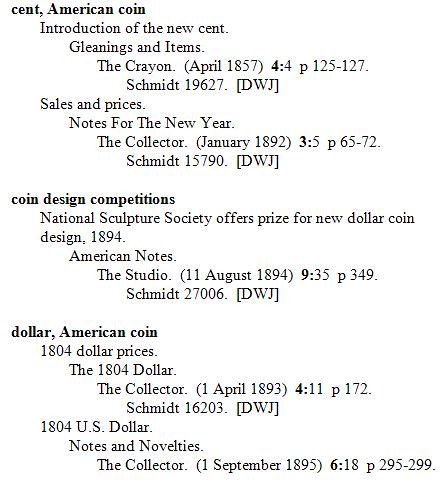
To read the earlier E-Sylum article, see: QUERY: STATUS OF THE NUMISMATIC INDEX OF PERIODICALS (www.coinbooks.org/esylum_v12n38a17.html)
PUBLISHING BOOKS, ONE COPY AT A TIME
On the Coin Talk message board, poster "sonlarson" announced the publication of his own sylloge World Silver Coins (see http://www.cointalk.com/t65563/). He wrote:
"I downloaded the software from Blurb.com. The software has several templates for the photo and for the text. You can use their templates or you can create you own. I used a combination. It looks simple, but is a lot of trial and error to make it look the way you want it. I had to retake the photos and resize to fit the pages twice. I also had to try a few different fonts and type size to fit the pages."
I asked specifically about the binding, whether the book was perfect bound from sewn signatures, for instance. He replied: "The completed book is just like you would buy at a book store." About editing your own work, he wrote: "I found about 15 grammar errors, which spellcheck did not catch." The finished product of 40 pages cost about $40.
Ahead of sonlarsen's responses, Coin Talk poster "krispy" also recommended Blurb.com and added: "Also, if anyone uses sites like Flickr for sharing photos, you can do similar things with QOOP and MOO.
Meanwhile, another aspect of one-off publishing made the news. From Wired Epicenter of September 17, 2009, comes news that
"Google Book Search, in partnership with On Demand Books, is letting readers turn those digital copies back into paper copies, individually printed by bookstores around the world.
"Or at least by those booksellers that have ordered its $100,000 Espresso Book Machine, which cranks out a 300 page gray-scale book with a color cover in about 4 minutes, at a cost to the bookstore of about $3 for materials. The machine prints the pages, binds them together perfectly, and then cuts the book to size and then dumps a book out, literally hot off the press, with a satisfying clunk. (The company says a machine can print about 60,000 books a year.)
"That means you can stop into the Northshire Bookstore in Manchester, Vermont, and for less than $10, custom-order your own copy of Dame Curtsey's Book of Candy Making, the third edition of which was published in 1920 and which can only be found online for $47.00 used."
To read the complete article, see: Google Lets You Custom-Print Millions of Public Domain Books (http://www.wired.com/epicenter/2009/09/google-books-publish-on-demand/)
To read the earlier E-Sylum article, see: THE ESPRESSO BOOK MACHINE: AN ATM FOR BOOKS (www.coinbooks.org/esylum_v11n38a22.html)
WILLIAM H. WOODIN
Dave Hirt writes:
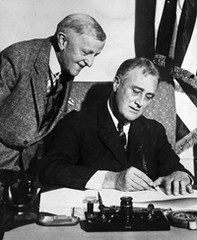 In last Saturday's Wall Street Journal there was an interesting picture of president Franklin D. Roosevelt signing the Emergency Banking Bill in 1933, with Secretary of the Treasury William Woodin leaning over his shoulder.
In last Saturday's Wall Street Journal there was an interesting picture of president Franklin D. Roosevelt signing the Emergency Banking Bill in 1933, with Secretary of the Treasury William Woodin leaning over his shoulder.
Looking at this photo reminded me how thankful that collectors can be that Woodin was in the position that he was to help save collectable coins from the gold recall.
In March 4, 1933, when President Roosevelt first took the oath of office, banks were closing their doors all over the United States as waves of panic led depositors to demand immediate payment of their money. Woodin was the point man in the Administration's declaration of a "Bank Holiday" which closed every bank in the U.S. until bank examiners could determine which were sound enough to re-open. With "seals of approval" from the examiners, depositors regained confidence, and the vast majority left their money in bank deposits. This became the fore-runner of the Federal Deposit Insurance Corporation and other such Federal guarantees intended to foster the trust which is essential to the entire financial system.
Woodin also presided over the Roosevelt Administration's withdrawal from the international monetary conference in London and decision to take the United States off the international gold standard. While he was Secretary of the Treasury, the Administration also began the decision-making process that eventually led to the Administration's decision to buy all the gold in private hands in the United States (other than that used by dentists and jewelers) and to devalue the dollar. Under Secretary Acheson was so opposed to the latter two decisions that he resigned in protest.
Woodin was also an avid coin collector, and when gold was withdrawn from private hands, he made certain an exception was put in place for "rare or unusual" coin types.
To read the complete article, see: William H. Woodin (en.wikipedia.org/wiki/William_H._Woodin)
NOTES ON JOHN KITTREDGE
Ken Bressett writes:
 I knew John Kittredge very well in my early days as a member of the New England Numismatic Association. Anyone who was involved with numismatics in the area back then knew John. He was a delightful person; always ready to pitch in and help with whatever project needed him; and a fine friend to all. I still keep up my membership in the organization because of all the fond memories I have as one of the original members.
I knew John Kittredge very well in my early days as a member of the New England Numismatic Association. Anyone who was involved with numismatics in the area back then knew John. He was a delightful person; always ready to pitch in and help with whatever project needed him; and a fine friend to all. I still keep up my membership in the organization because of all the fond memories I have as one of the original members.
Bob Fritsch writes:
John Kittredge was my friend and colleague. He was a fixture of long standing on the NENA Board by the time I became President in 1994. Unfortunately he had recently suffered a stroke, so many of our meetings were at his house in Worcester, MA. In later years we made him a Director Emeritus to give him a permanent place on the Board. Friends would bring him to meetings as he couldn't drive, and we often celebrated a successful meeting with lunch at a local restaurant.
The Kittredge Foundation is in the capable hands of Worcester attorney and collector Matt Erskine. One exhibit at the Worcester Historical Museum has successfully concluded and a second is about to open. A "Treasures in your Pockets" day will be on 17 October, right after the opening. I am privileged to serve on the Foundation's Board along with New England numismatic luminaries Prue and Arthur Fitts, John Sallay, Bob Moffatt, and Bob Hewey.
Matt Erskine writes:
Bob Fritch, one of your subscribers, cc. me on the comment on the query of the Kittredge Collection website. I am the Trustee of the Foundation, which has an advisory Board as noted by Bob. The purpose of the foundation is to preserve John Kittredge's collection of over 7,200 crowns and talers, and promote numismatics particularly in the central New England region.
The website was developed by Ethan Gruber, a graduate student at the University of Virginia, who also developed the UVA coin site. We have used open source code for the side, and would be happy to share the code with anyone who is interested. It is formatted in a way that is in compliance with the standards of archivist and museums, but I also hope is helpful for the dealer and collector.
We have also developed a "non-numismatic" program, which if anyone is interested in working on getting an online bibliography of numismatic references I would be happy to help with the program, especially if the references are sources of interest in collecting coins that John was also interested in.
As for myself, I am the fourth generation of my family who have practiced law in Worcester MA, providing succession planning for owners of unique assets such as coin collections.
To read the earlier E-Sylum article, see: FEATURED WEB SITE: THE KITTREDGE COLLECTION (www.coinbooks.org/esylum_v12n38a32.html)
MORE ON THE STANDING LIBERTY QUARTER DATE
Regarding Roger Burdette's item about the easily-worn pre-1925 Standing Liberty Quarters, Dave Lange writes:
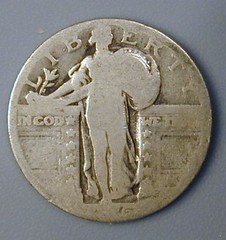 To show just how rapidly the dates wore from 1916-24 Standing Liberty Quarters, a useful source is a 1938 survey of 5,000 circulating quarters made by Dr. J. Robert Schneider and published in the Numismatic Scrapbook Magazine. It reveals that of 1520 pre-1925 Standing Liberties examined, all but 58 were dateless! This was just 22 years after the type had been introduced.
To show just how rapidly the dates wore from 1916-24 Standing Liberty Quarters, a useful source is a 1938 survey of 5,000 circulating quarters made by Dr. J. Robert Schneider and published in the Numismatic Scrapbook Magazine. It reveals that of 1520 pre-1925 Standing Liberties examined, all but 58 were dateless! This was just 22 years after the type had been introduced.
MORE ON THE 1959 HAWAII GOLD STATEHOOD MEDAL
Thanks to Jan Monroe for offering the information regarding the mintage of this piece. I would sincerely appreciate a citation to the research which Jan did to arrive at the mintage of 58, so that I can answer appropriately any inquiries I may receive in the future about the basis for that mintage figure.

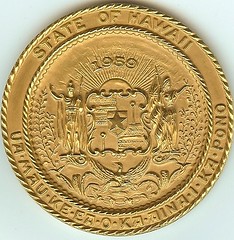
I still contend that it's more than reasonable that a number of both the Hawaii and Alaska gold medals would have been melted in spite of the fact that the issue price was $850, as Jan properly states. In 1980 those medals that were purchased some 20 years before for $850 would have melted at well over $5,000 when gold was $800 per ounce.
I recently weighed one of these gold medals at precisely 217.5 grams, which is exactly 7 ounces. However that 7 ounces is only 900 Fine, and so stamped on the edge, resulting in these medals containing 6.29 ounces of gold.
Joe Boling adds:
When gold hit $800 back on the '80s, it would have been a perfect time for a buyer who wondered if he would ever get out from under that $850 price to take his profits and run (gleefully). I'd not be surprised if MOST of the medals were melted - at $5000+.
Dick Johnson writes:
I answered most collector questions when I was at Medallic Art Company (1966-77). To answer such a question (as the Hawaii Statehood Medal) I would search the files. There were always two file folders: (1) correspondence and (2) shop orders. Correspondence was always between the salesman and the clients. The shop orders always contained the hard facts.
I would gather the pertinent facts and dictate a letter to whoever asked a question. Then I would type up a "green card" with these facts and file that in the archive card file. Before I left the company I made copies of these green cards and this is where I got the facts I submitted to Jan Monroe.
Here is the exact text of that green card:
| Hawaii Statehood Medal, 1959 | 59-92 |
| Quantity Struck: | |
| 2 1/2-inch (63mm) gold (limited 100) . . . . . . . . . . | 58 |
| 2 1/2-inch (63mm) silver (unnumbered). . . . . . . . | 154 |
| 2 1/2-inch (63mm) silver (serially numbered) . . | 3,000 |
| 2 1/2-inch (63mm) bronze . . . . . . . . . . . . . . . . | 29,599 |
On a second green card:
| Hawaii Statehood Medal, 1959 | 59-92 |
| Notes: | |
| Gold medals numbered up to 55, 59, 69, 100 (total 58) | |
| Official distributors: Coin & Currency, N.Y.C. for US.; Edward D. Sultan Company, Ltd, Honolulu for Hawaii. | |
| Silver unnumbered medals (154) went to Governor James K. Kealoha in Honolulu. |
I cannot guarantee any number beyond what I had recorded on the green cards. All the original files have long since been discarded. Of more than 6,000 items I cataloged before 1976, I estimate I had green cards on perhaps 20. So I am not a source of quantity struck data for any Medallic Art Co item.
To read the earlier E-Sylum articles, see:
QUERY: 1959 GOLD STATEHOOD MEDALS FOR ALASKA & HAWAII
(www.coinbooks.org/esylum_v12n36a20.html)
THE 1959 HAWAII GOLD STATEHOOD MEDAL
(www.coinbooks.org/esylum_v12n37a14.html)
COINS PICTURED ON BANKNOTES
Brent Zimmerman writes:
I hadn't written earlier on this subject, as I thought for sure someone would have written back with this U.S. note. The 1886 $5 silver certificate has five Morgan silver dollars pictured on the reverse - four of them showing the coins' reverse and one in the center showing the obverse along with the 1886 date under Lady Liberty.
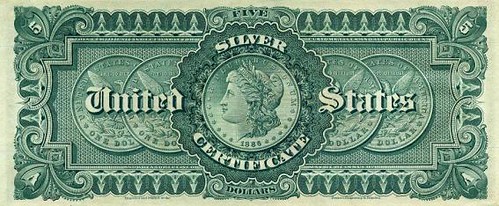
I also believe the National Gold Bank notes have gold coinage depicted on the back of the notes. I haven't added the value of the coins up, but Clifford Mishler has written in his book Coins: Questions & Answers that they add up to $211! I imagine there are more notes and coins with coinage on them as well.
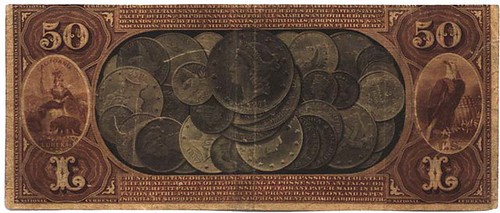
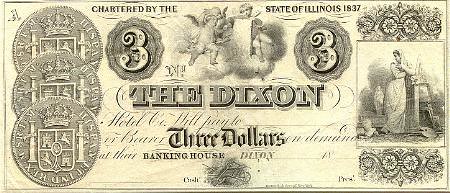
Vignettes of coins of the Spanish American colonies, and less commonly those of homeland Spain, were used on many US obsolete notes. As such they may have served as indications of value to a public justifiably reluctant to accept paper money. Spanish coins were familiar to United States residents, and they were esteemed widely for uniform and high quality and stable value.
Spanish coin vignettes were used on our colonial currency as well as obsolete notes.
This exhibit examines a selection of post-colonial US obsolete notes that have depictions of Spanish coins.
To read the complete article, see: Spanish Coins on American Notes (http://scoan.oldnote.org/)
So what name can we give notes picturing coins equaling the note's denomination? How about "denomographic" or "autodenominated" ? -Editor
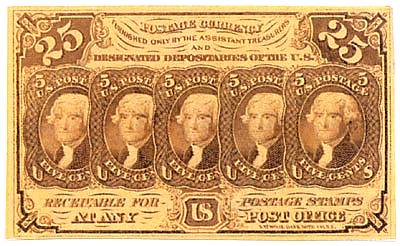
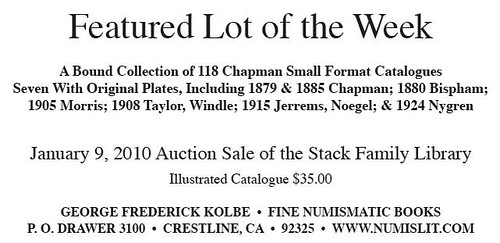
MORE ON ADMIRAL NELSON'S MEDALS
Darryl Atchison writes:
I received last week's E-Sylum which was - as usual - full of interesting tidbits to tease the enquiring numismatist. The article about the theft of Nelson's medals was particularly timely for me as we had only just returned a couple of weeks ago from visiting Nelson's and Wellington's tombs in the crypts of St. Paul's Cathedral in London. We were equally enthralled and creeped out at the same time.
Yossi Dotan writes:
Are you sure that the body of Admiral Lord Nelson was brought to the Painted Hall to lie in state in 1802? The battle of Trafalgar, in which Nelson died, took place three years later, in 1805. -Editor
Jim Duncan of New Zealand writes:
I was intrigued to read your piece about Nelson's stolen medals.
I have a book, open as I speak, "Nelson's Purse" which tells the story of a stocking purse and much else Nelsonian, which the author Martyn Downer auctioned at Sotheby's in 2002. Page 329 says "...in the second drawer of the chest (was) a bag with Gold and Silver coins (guineas, 1/2 guineas).
Alongside the purse was a silver Nile medal, a gold snuff box made from the mast of the victory Lord Nelson's flagship at the Battle of Trafalgar on which he was killed, and, most intriguing of all, the Gold Nile medal worn by the immortal Nelson when he fell 21st October 1805 at Trafalgar."
This reference is from an inventory compiled in 1866 of material which disappeared until rediscovered in 2002, and says that this was the medal he had worn when he died. (Spelling in quote as per book, and therefore inventory).
Could this be the same medal about which you report? Downer was at Sotheby's from 1993 until 2003, when he was Head of Jewellery. The medal is illustrated courtesy Sotheby's. The book was fascinating, and detailed much of the work of Alexander Davison, Nelson's Prize Agent.
A further read has reminded me that Davison was Nelson's executor, and the chest of drawers in which the Nile medal was found was in Swarland Hall, Davison's home, and the finder was his son William, then a very old man. The book I quoted was published in 2004, oddly enough.
I have further discovered that Nelson gave his gold medal to Captain Hardy, who for some reason missed out, and told Davison that he (Nelson) would be happy with a silver or copper piece! But I think this just makes the whole thing more confusing, don't you? This was from a Google search, which brought me to a book written in the 19th century.
To read the earlier E-Sylum article, see: THE 1900 THEFT OF ADMIRAL NELSON'S MEDALS (www.coinbooks.org/esylum_v12n38a28.html)
MORE ON THE YOACHUM DOLLAR MYSTERY
Bruce Smith writes:
A few years ago there was some discussion on E-Sylum about the Missouri Yoachum Dollar (and various spellings of Yokum). If anyone is interested in this subject, I have a thick file on the matter, going back to the 1976 when I first became aware of these fantasy dollars. I think I know who made them and why. I can be reached at chinasmithbr@yahoo.com.
To read earlier E-Sylum articles, see:
QUERY: YOACHUM SILVER DOLLAR: APRIL FOOL?
(www.coinbooks.org/esylum_v11n15a21.html)
COMMENTS ON THE YOACHUM DOLLAR
(www.coinbooks.org/esylum_v11n16a12.html)
THE BOOK BAZARRE
QUERY: THE ORIGIN OF COIN AND MEDAL DIE ALIGNMENT
The reason I am writing to is in relation to the superb Stack's 2009 'Philadelphia Americana' sale catalogue which I received last week. I took a few hours to read the catalogue over the weekend and a couple of observations sprang to mind:
1. In reference to lot no. 4001 (a Massachusetts Oak Tree Shilling), I couldn't help but notice the planchet cut which occurs on the left-hand-side of both the obverse and reverse of the coin.
This got me thinking about die alignments - which, admittedly, was not something I paid particular attention to prior to this. I have, of course, heard of 'coinage alignment' and 'medal alignment' and I know the difference between these but hadn't really given the matter much more thought before now.
No doubt, Dick Johnson or some other expert on minting technology can answer the following questions.
a. Where or when did the these terms 'coinage alignment' and 'medal alignment' originate?
b. Were the different alignments ever used in a monetary sense to differentiate between metal objects which were produced as medals versus coins or vice versa? (i.e. does anyone actually think that your average punter could determine the intended purpose of a particular lump of metal which was cast, engraved or stamped with a particular alignment versus another alignment.
This seems highly improbable to me but perhaps there is evidence to the contrary. Most numismatists/collectors today I think could and would intrinsically deduce the intended purpose of a lump of metal based on other characteristics of the object itself (ie. the use of a denomination, legends, design elements, metallic composition, etc.).
After a bit of thought on the matter, I now believe that these alignments were use for more practical reasons.
First of all you must assume that someone who wants to distinguish between a genuine coin/medal and a counterfeit would always want to examine the piece with the design in its correct upright position.
Let's look at the case for identifying coins first...
Pretend for a minute that you are an early 19th century merchant examining the coins that have just been placed on your countertop. Place some coins in front of you and one by one scoop the coins up using your thumb and index finger. If you are right-handed, your two digits will naturally end up at the 3:00 position on the coin and if you are left-handed they will end up at the 9:00 position.
Hold a coin by the edge at the 3:00 (or 9:00) position between your thumb and index finger so that the obverse is facing you and the design of the coin is correctly positioned in an upright position. Assuming that your thumb is facing you, the easiest way to see the reverse of the coin (with the design in its correct upright position) without having to touch the coin with your other hand is to roll your wrist towards you so that the coin naturally flips over in the process. If your index finger was facing you, simply roll your wrist away from you instead.
Notice that the design that was at the bottom of the reverse when you were looking at the obverse has now become the top of the design when the coin flipped over. Although it is harder and much more awkward to do, you can replicate this experiment if you hold the coin as 'collectors ' do today (i.e. at two points on the edge using your thumb and index finger). Being only concerned with identification and not preservation, merchants would have handled hundreds of coins a day and would not have worried about touching the coin's surfaces and would have most certainly used the method described above.
Naturally, the merchant wouldn't have worried about which side he looked at first nor would he have bothered to ensure that the coin was accurately 'lined' up before examining the other side since he could easily examine the coin in a sideways or rotated position. It just gets a little harder to study the coin quickly the closer the design gets to being rotated to 180 degrees as it takes longer for your eyes to study and assess the design elements. And you must remember that speed was essential to the merchant for whom time meant money.
To achieve this effect, the dies had to be placed so that the obverse die was placed in an upright position with the top of the design at 12:00 and the reverse die was placed in a downwards position so that the top of the design was positioned at 6:00. This is called 'coinage alignment'.
As for medals...
Again, you must assume that the position of the dies is based on the necessity to observe the finished obverse and reverse designs in their correct upright positions using the simplest method. I think that most people would agree that the earliest forms of medals were intended as gifts or decorations to recognize merit or accomplishment and that these pieces were also intended to be worn by the recipient. As such, if you were holding the piece by either a ribbon or suspension loop it would not be physically possible to view the reverse design using the method previously described above - and still have the loop or ribbon correctly positioned at the top.
Whether one is holding the medal in question or viewing it while it is being worn, the easiest way to see the reverse is to simply turn the piece over (ie. left to right or right to left) so that the ribbon or loop remains at the top the whole time. Similarly, the design elements on the reverse remain correctly upright when you turn the medal over.
To achieve this effect, both the obverse and reverse dies are placed in an upright position so that the top of both designs are at 12:00. This is called 'medal alignment'.
To summarize, the eventual form (i.e. alignment) of the finished pieces was based entirely on the functionality of the piece in question and was not accidental. At least, that explains the historical usage of the two alignments.
Having said that...
Perhaps someone more knowledgeable than myself can explain why most coins struck today have the 'medal alignment'. Is this because of collectors who store their coins in holders in pages who want to be able to see both obverse and reverse of their coins correctly when looking at their coins in albums? Or is there no longer a need to examine a coin to determine its authenticity due to the standardization of coinage production (ie. all of the coins of a given series issued today are virtually identical which was not the case prior to the industrialization of coinage production two centuries ago)? Or is there possibly some other reason? I simply don't know.
QUERY: CATALOG DESCRIPTIONS OF RARITY
My second observation regarding the 2009 Stack's 'Philadelphia Americana' sale concerns the question of relative rarity. I could have directed this question directly to Stacks I know, but thought this might also generate some discussion on the way cataloguers describe particular lots.
While studying this phenomenal catalogue, two lots in particular captured my interest. Both are described as being Indian Chief Peace medals - thus both should be equally desirous to collectors of this series.
If you examine the description for lot no. 6108, the medal in question is identified as the 1761 Montreal Medal and is described as "an extraordinary rarity". The cataloguer states that there are seven listed (or known) medals of which only four can be traced. Three of the traced medals are currently in institutional collections which leaves the medal currently up for auction as the "only specimen in private hands". There may be an implied inference here that the other three un-traced specimens may someday surface but as "no collection of early American Indian peace medals is complete without this medal", the underbidder may have to wait a lifetime or longer for this happen.
By comparison, if you read the description for lot no. 6106, the medal in question is identified as a circa 1644-1676 Calvert Indian Peace medal. The cataloguer states that there are three (or possibly an unconfirmed four) known specimens with two in institutional collections. Again, this leaves the medal currently up for auction as possibly the only one available to the private collector. Curiously, reading further into the lot description you find the following statement, "This ranks with the (more common) Montreal medal as an enviably historic Indian Peace medal without which no Indian Peace medal collection can be complete".
Now, unless I have somehow missed or mis-read the cataloguer's point, I cannot see how the two medals described above - each with only one specimen currently available to private collectors - are not equally rare.
At the very least "(more common)" can be viewed as optimistic over-statement on the cataloguer's part.
THE U.S. MINT AT THE DULLES, OREGON
Brent Zimmerman writes:
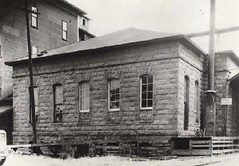 In addition to Philadelphia, the current mints are the famous San Francisco branch mint, the Denver Mint and the toddler West Point, N.Y., facility which has been in business since only 1973 as compared to 1792, 1854 and 1906, respectively, for the other three.
In addition to Philadelphia, the current mints are the famous San Francisco branch mint, the Denver Mint and the toddler West Point, N.Y., facility which has been in business since only 1973 as compared to 1792, 1854 and 1906, respectively, for the other three.
But how many of us have heard of the U.S mint that was located in The Dalles in Oregon? Could we have had a "TD" mintmark? Or perhaps "DC," as it was originally known as Dalles City. I invite you to take a walk with me, back to the mid-1800s, as we learn about this fascinating story, and some of the people and the events that transpired.
Then called Dalles City, it was the departure point in the 1840s that thousands of pioneers, bypassing the mountains, rafted down the Columbia river to the Willamette river, and settled in its rich western Oregon valley.
The Dalles was the end of the land route of the Oregon Trail.
The gold strike news spread like wild fire. The "flames" fanned out into all the Owyhee country - eastern Oregon and parts of Idaho, Washington and Montana. Prospectors swarmed in. In 1862 there were some 80,000 prospectors who were seeking and finding their fortunes. It was a full-fledged gold rush. This also led to demands for a mint to be built in the region.
The Dalles, nerve center of the vast gold rush, reached a population at times of 10,000, counting those coming in from the diggings, or going to them. It was here that the raw gold seemed to always flow. It was a busy, rip-roaring city. Business boomed, including such 24-hour conveniences as saloons, gambling joints and houses of ill repute. Every man carried a handgun.
Some years later, the Dalles Chronicle commented on the times: "Payment for all commodities was made in gold dust. The god of gold reigned supreme in The Dalles. Human values were forgotten. Bags of gold were handled about as freely as other commodities. They were passed across the counter and gambling tables or bars in payment (of) merchandise, debts or drinks. There was no service for less than $1. The Wells Fargo Express Co. carried the gold dust and bullion to the San Francisco mint by boat". Gold coins, nearly all of the Coronet type, were the media of exchange, although gold dust was accepted. Silver coins were few and far between, with any that were found being mostly the Seated Liberty design.
On the blueprints, the design for the mint building was well proportioned and attractive. To the non-architectural eye, it was shaped like two rectangles, one larger than the other, placed across each other. The Carson City Mint is of similar design. Plans at The Dalles called for the lengthwise portion to be just over 90 feet, by almost 51 feet. The crosswise section, which had the main entrance at one end and an engine-boiler room attached at the rear, was 63 feet by 51 feet, 8 inches.
"The building is to be two stories high, having a basement under all of it", stated A.B. Mullet, the Treasury departments' supervising architect. "It will be constructed of stone and brick, portions of it will be groined for brick floors and portions will have wooden floors". The blueprints were complete for the mint, but never entirely used to complete the building.
To read the complete article, see: Mint that Never Was Makes Interesting Tale (http://www.numismaster.com/ta/numis/Article.jsp?ad=article&ArticleId=7049)
To read the earlier E-Sylum article, see: IT MIGHT HAVE BEEN: THE U.S. MINT AT DALLES CITY, OREGON (www.coinbooks.org/esylum_v09n11a28.html)
THE BOOK BAZARRE
NEWSPAPER ARTICLES HIGHLIGHT MARK YAFFE'S ORCHESTRIONS
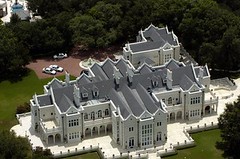 Mark Yaffe's 300 guests could have easily mistaken him for a lord of a bygone era as he ushered them under a 10-foot high Venetian glass chandelier in the great hall of his mock English Jacobean palace.
Mark Yaffe's 300 guests could have easily mistaken him for a lord of a bygone era as he ushered them under a 10-foot high Venetian glass chandelier in the great hall of his mock English Jacobean palace.
Yaffe was hosting a fundraiser for Hillsborough County Community College that night in 2005, attended by the high and mighty of Tampa. Baseball Hall of Famer Wade Boggs was there. Actors in medieval costumes mingled among them.
Waltzing through the surroundings, it seemed obvious: Yaffe had arrived.
He was a college dropout who rose to head National Gold Exchange, a Tampa-based coin wholesale business that brought in half a million dollars a week.
But behind the glitz, Yaffe's empire was on shaky ground. This summer, his bank demanded he repay a $35 million business loan. Hidden in the bankruptcy court documents: Yaffe was nursing a multimillion-dollar passion that was eating away his business, the bank said.
Yaffe had blown through tens of millions of dollars on his collection of antique music machines and the mansion he had custom built to display them.
Colleagues describe Yaffe as an introvert with a genius' attention to detail. He can plow through a pile of 1,000 gold coins and, using his trained eye, immediately pinpoint the fakes by noting nearly microscopic mint marks.
Yaffe moved to Tampa in 1988, ensconcing himself in a 10,000-square-foot house in the exclusive Avila community in North Tampa. That's when he developed his second great passion: music machines.
Yaffe applied his talent for detail to assembling one of the world's best collections. He described the allure during a brief interview after a recent bankruptcy hearing in Tampa. Forty-nine years old, with salt-and-pepper hair above a pair of accountant's glasses, Yaffe came alive when he described the hobby.
"Consider a painting on the wall," he said, gesturing to a framed print hanging in the courthouse. "After a while you get bored just looking. With these machines you can listen to beautiful music. And on top of that, they're works of art."
The collection grew so fast that Yaffe was forced to stash machines in his garage, in off-site warehouses, even in his brother's house.
"These things are fun to show off," Goldman said. "You don't have to lock them away in a vault like a coin collection."
"Some of these things are 12 feet tall. You can't put them in your standard 8-foot-ceiling house,'' Goldman said. "These collections dictate where you live.''
First Yaffe had to finish the house. As the home progressed, he continued to grow the collection. In 2000 he bought a rare Hupfeld Helios, a cabinet containing 256 pipes that mimic clarinets, flutes, cellos and other instruments. The seller was Fisher Nut's Sanfillipo. He drove a hard bargain, charging Yaffe $1.2 million. Yaffe paid $352,000 to restore it.
Yaffe took out several mortgages worth millions. What had started as a relatively modest 12,000-square-foot blueprint had ballooned into the 29,000-square-foot palace. Once, to tide things over, Yaffe asked a neighbor for a $200,000 loan.
The bank seized all of Yaffe's coins, effectively putting National Gold out of business. They're locked away in a Brinks vault. Ahead lies months of wrangling in bankruptcy court. The music boxes remain secure in the regal splendor of Yaffe's mansion, under the watchful eye of the federal courts.
To read the complete article, see:
The fortune Mark Yaffe made in coins collapses under his other collection
(www.tampabay.com/news/business/realestate/the-fortune-
mark-yaffe-made-in-coins-collapses-under-his-other-collection/1039185)
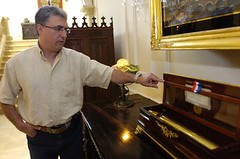 Even by Avila's opulent standards, Mark Yaffe's home is something to behold.
Even by Avila's opulent standards, Mark Yaffe's home is something to behold.
With 10 bedrooms and 14 fireplaces, the 29,000-square-foot manor rises from the estate like an English countryside castle. What's inside, however, may be even more striking. The Yaffe household is a shrine to more than 100 self-playing antique mechanical musical instruments.
Some are worth at least $1 million, including the real showpieces: "orchestrions" - boxy devices with mechanical arms that pound drums, plink a xylophone and tickle piano keys.
To read the complete article, see: Antiques hold million-dollar melodies (www2.tbo.com/content/2009/sep/27/na-million-dollar-melodies/)
FORMER ANA EXECUTIVE DIRECTOR FACES HEARING MONDAY
A hearing to determine whether Colorado Springs attorney Christopher Cipoletti should be suspended from practicing law will be held Monday in Denver before a disciplinary judge whose office is affiliated with the Colorado Supreme Court.
The development is the latest in a string of legal actions that have been ongoing since October 2007, when Cipoletti was fired as executive director of the American Numismatic Association, based in Colorado Springs.
The Economic Crimes Division of the Fourth Judicial District Attorney's Office opened a criminal investigation into Cipoletti several months ago, after the ANA added accusations of theft to a civil lawsuit that names him as a third-party defendant regarding more than $400,000 in unpaid bills owed to a Denver law firm.
A 15-page report the arbitrator issued in May ruled in favor of the ANA, saying Cipoletti not only was not entitled to further compensation but also intentionally stole more than $9,000 from the organization during his employment and breached his fiduciary obligations and duties of loyalty.
The arbitrator cites instances of Cipoletti double-billing private legal clients and the ANA for expenses on trips he took for speaking engagements. The arbitrator also found that Cipoletti was getting paid by the association while doing work for clients of his private legal practice.
In an affidavit on the suspension of his law license, Cipoletti said he voluntarily stopped practicing law in August, after receiving a copy of the complaint the ANA filed with the state's Office of Regulation Counsel.
If Cipoletti's license is suspended, he will face further disciplinary action, said Rob McCallum, spokesman for the State Court Administrator's Office.
The district attorney's office is still investigating whether to file criminal charges, according to senior deputy district attorney Robyn Cafasso.
To read the complete article, see: Springs lawyer facing hearing on license suspension (http://www.gazette.com/articles/springs-62597-colorado-attorney.html)
RARE CENTS OF WILLIAM THE CONQUEROR UNCOVERED
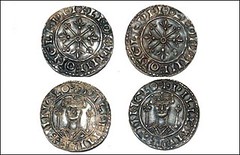 Four silver coins dating from Norman England have been found in Gloucestershire.
Four silver coins dating from Norman England have been found in Gloucestershire.
It is believed they were minted in Gloucester in 1073-1076 and represent an unrecorded type of penny.
Archaeologist Kurt Adams said the coins, which are just 0.8mm thick and about the size of a 10p piece, were incredibility rare.
Reports of the coins are already exciting collectors because of their rarity, Mr Adams said.
"Coins dating to the age of William I [William the Conqueror] are very rare finds, but these are unique," Mr Adams said.
To read the complete article, see: Rare coins find excites experts (news.bbc.co.uk/2/hi/uk_news/england/gloucestershire/8274509.stm)
AN UNPARALLELED FIND OF ANGLO-SAXON GOLD AND SILVER
The UK's largest haul of Anglo-Saxon treasure has been discovered buried in a field in Staffordshire.
Experts say the collection of 1,500 gold and silver pieces, which may date to the 7th Century, is unparalleled in size and worth "a seven-figure sum".
The Staffordshire hoard contains about 5kg of gold and 2.5kg of silver, making it far bigger than the Sutton Hoo discovery in 1939 when 1.5kg of Anglo-Saxon gold was found near Woodbridge in Suffolk.
Leslie Webster, former keeper at the British Museum's Department of Prehistory and Europe, said: "This is going to alter our perceptions of Anglo-Saxon England as radically, if not more so, as the Sutton Hoo discoveries.
"(It is) absolutely the equivalent of finding a new Lindisfarne Gospels or Book of Kells."
To read the complete article, see: Huge Anglo-Saxon gold hoard found (news.bbc.co.uk/2/hi/uk_news/england/staffordshire/8272058.stm)
MALAYSIA'S MAYBANK NUMISMATIC MUSEUM
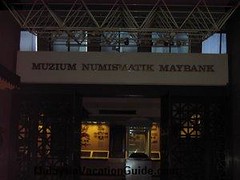 This museum is located in the city centre of Kuala Lumpur in the Maybank Tower near Puduraya. Although not as comprehensive and decorated as well as Bank Negara Money Museum, it has an impressive collection of coins and notes that go way back to the time of the Malacca Sultanate, the occupation of Malaya by the Portuguese, Dutch, British and Japanese during "World War 2.
This museum is located in the city centre of Kuala Lumpur in the Maybank Tower near Puduraya. Although not as comprehensive and decorated as well as Bank Negara Money Museum, it has an impressive collection of coins and notes that go way back to the time of the Malacca Sultanate, the occupation of Malaya by the Portuguese, Dutch, British and Japanese during "World War 2.
For students who are serious on the history of numismatic, this museum is a good place to go to enhance your knowledge in this area.
The numismatic collection include the following:
- Miniature Cannons were used in Borneo as currency by the natives. They were used for bartering, wedding gifts and for barter trading. A real cannon is usually fired during weddings, births and visits by the VIPs.
- Malacca Sultanate 1400-1511 merchants used gold dust, silver bars and blocks of tin instead of coins. As more traders come in from the Middle East, Pasai coins were introduced during the reign of Sultan Muzaffar Shah.
- Portuguese Occupation 1511-1641 saw the introduction of the currency in the form of gold catholico, the silver malaquese, bastardos, soldos and dinheiros in an alloy of tin and lead.
- Malay States Currency in the form gold coin called "mas kupang" was used during the reign of Sultan Abdul Jalil Shah III from 1623-1677. In Kedah, the animal currency in the form of fighting cock was used in the 16th century. Tin ingots currency in the shape of an elephant and crocodile were used in Selangor and Perak.
To read the complete article, see: Maybank Numismatic Museum (www.malaysiavacationguide.com/numismatic.html)
FEATURED WEB SITE: KYOTO UNIVERSITY'S ECONOMIC REVIEW
This week's Featured Web site is suggested by Bruce Smith, who writes:
This is the Economic Review from Kyoto University in Japan. The link will bring up a page with a list of articles on the left and a blank screen on the right. The articles are from the annual Kyoto University Economic Review (KUER), from 1926 to the present -- listed in reverse chronological order.
All the articles are in English, except for a few in German. There are a number of articles on currency in China, Japan and southeast Asia, mostly published in the 1930's and 1940's. Several articles relate to currencies issued by the Japanese in China and Southeast Asia during World War II.
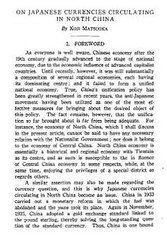
www.econ.kyoto-u.ac.jp/review/

